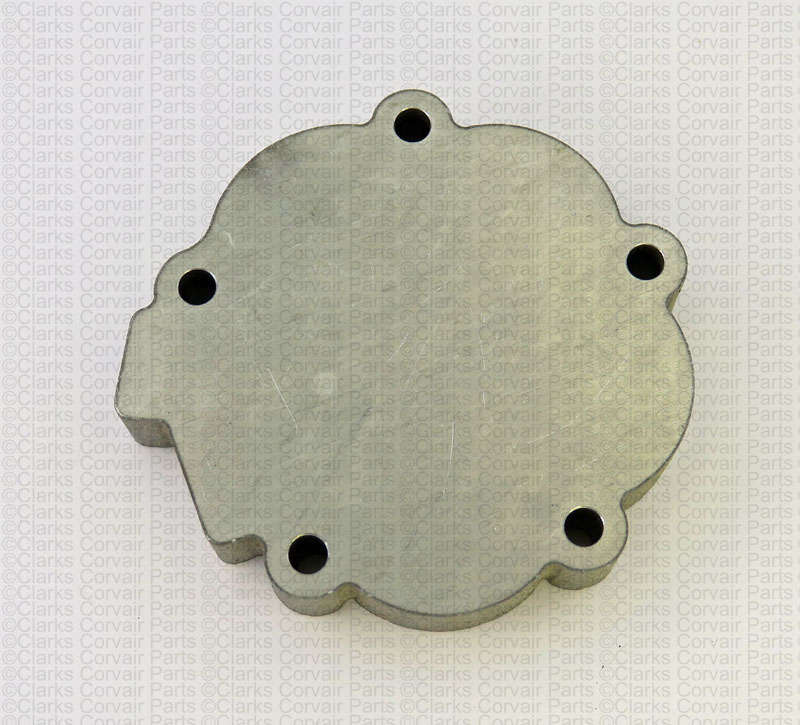Page 1 of 2
Quick fuel pump question
Posted: Wed Jun 07, 2023 12:20 pm
by atomicmoloch
I am a very new Corvair owner and I just picked up a '60 cave car yesterday, so I apologize if this is a sortof inane question but what's the easiest way to tell if my fuel pump has a 60-61 or a 62-69 pump rod?
Re: Quick fuel pump question
Posted: Wed Jun 07, 2023 1:26 pm
by gbullman
I believe you have to remove the pump and inspect it and the push rod. The catch is there is only about 1/16” difference between the 2 so looking at either one alone it is hard to tell.
Check out this post when I tried to replace my late model mechanical fuel pump. The pump with the retaining hole is a 62-69.
viewtopic.php?t=17361
Are you just curious or having an issue?
Re: Quick fuel pump question
Posted: Wed Jun 07, 2023 4:26 pm
by bbodie52
As outlined in the Shop Manual instructions below, the mechanical pump should be tested for BOTH adequate pressure and fuel volume delivery. (A pump can have the correct pressure output, but fail to deliver adequate fuel volume to refill the float bowls).
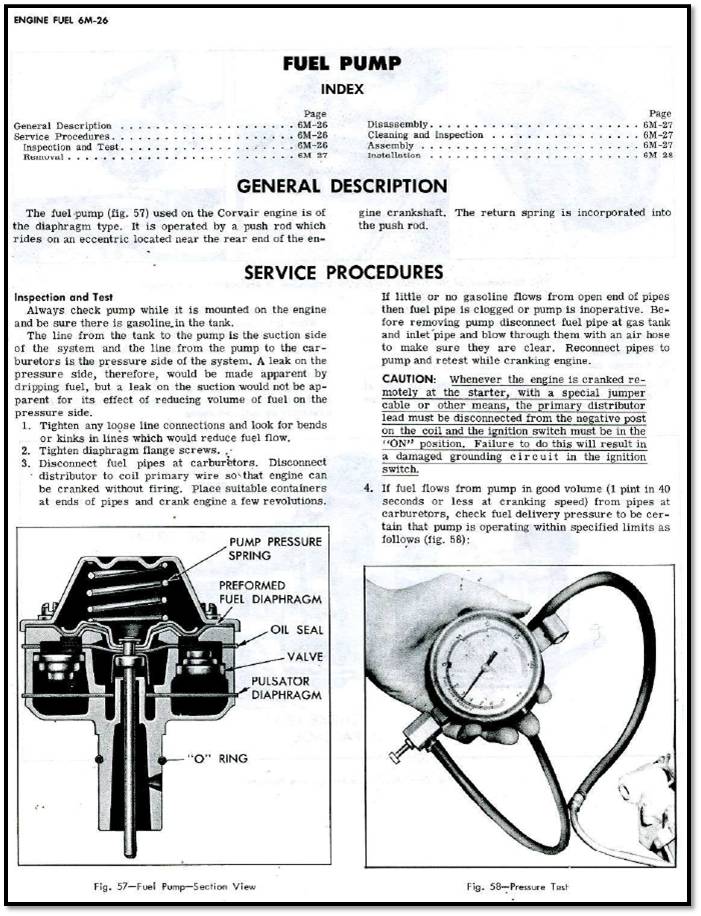
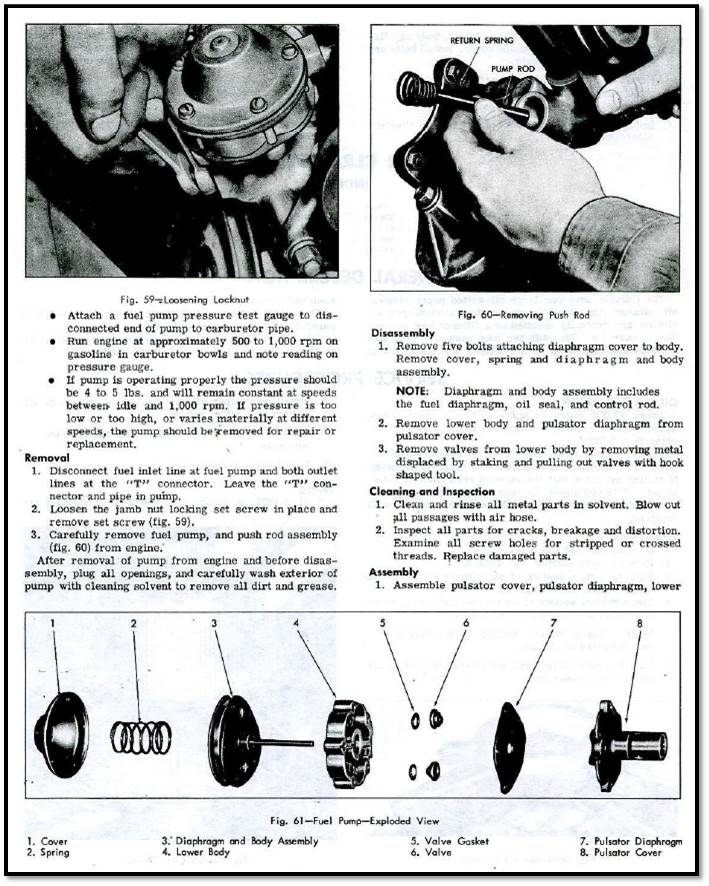
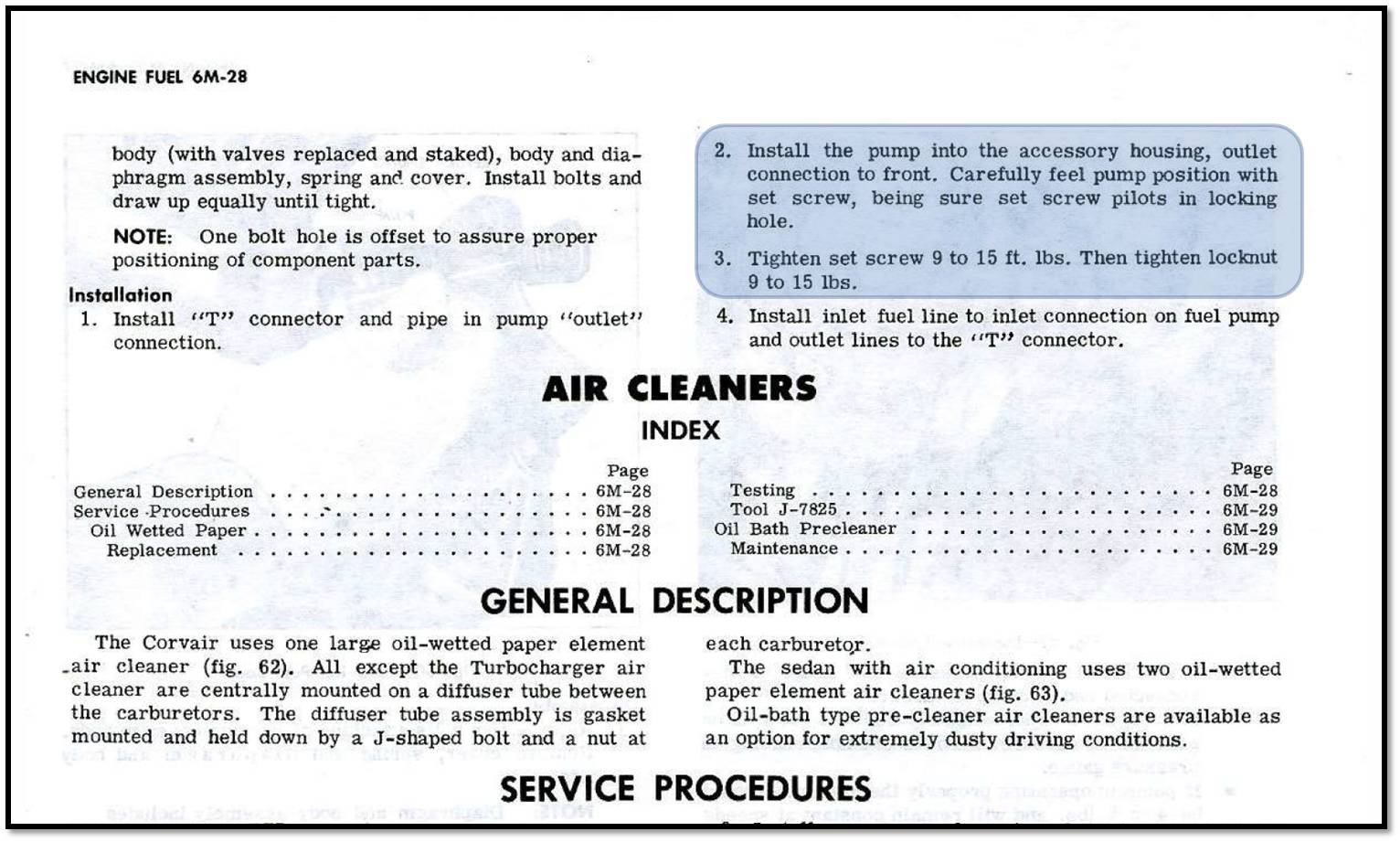
NOTE: A fuel pump that is not delivering adequate fuel volume to support an engine that is being driven on the road could conceivably produce enough volume to support an idling engine.
The second test measures fuel flow at the fuel pump outlet. The standard in the shop manual states that the pump should be able to deliver 1 pint of fuel over a period of 40 seconds or less at engine cranking speed. If your pump does not appear to have any leaks and can pass the output pressure test, but fails to deliver the needed fuel volume, the problem may not be with the pump itself.
There is a long fuel line that runs the length of the car from the fuel tank to the fuel pump.
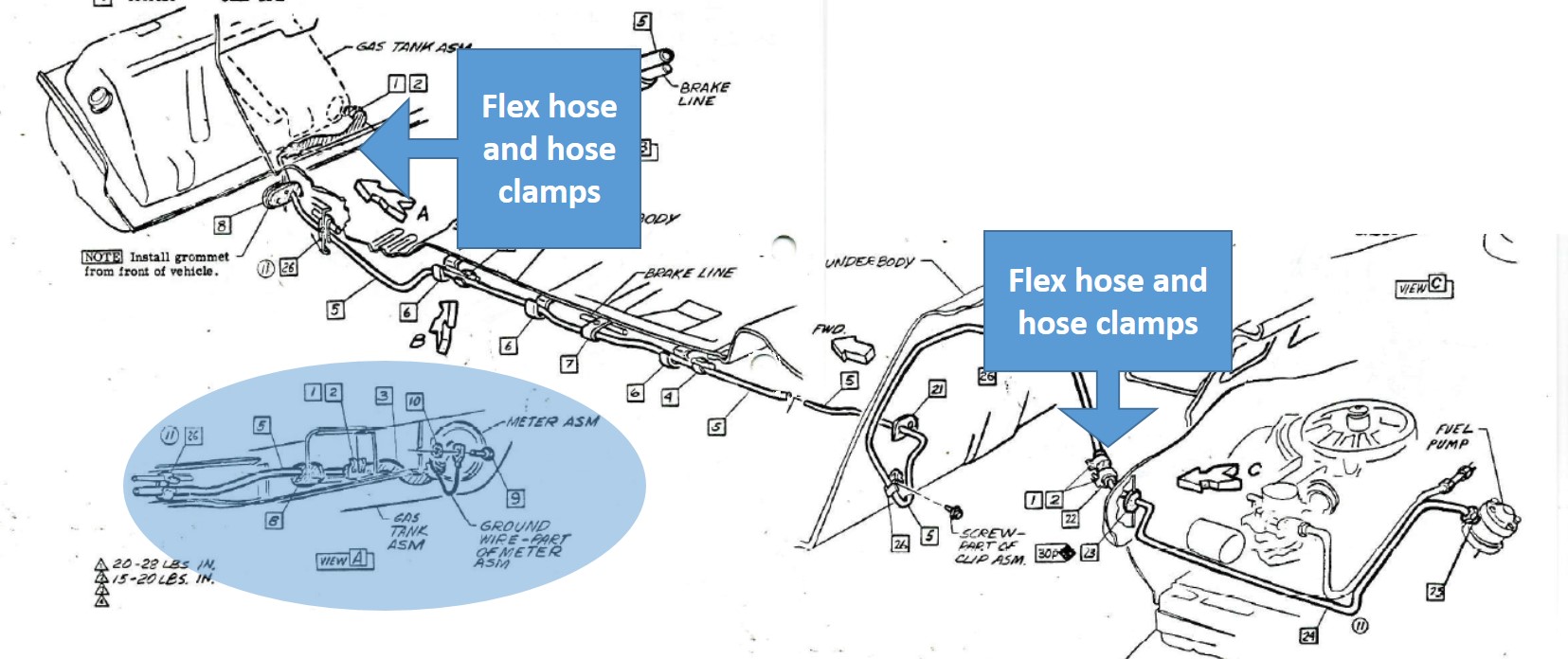
In order to pressurize and deliver fuel to the carburetors, the pump must be able to create a continuous vacuum in that fuel line to draw the fuel from the tank to the pump. Most of the fuel line is made up of steel tubing and is unlikely to develop a leak. However, there are two short lengths of rubber fuel hose in the fuel path. One section of hose is found at the fuel tank outlet, while the other is found adjacent to the starter motor — just before the line enters the engine compartment. The purpose of the second hose is to absorb vibration from the engine and prevent it from reaching the rigid steel fuel line. If either one of these two hoses develops a leak, the leak itself may not be apparent because the line is not under pressure so fuel will not be forced out. Instead, the leak amounts to a vacuum leak, which can allow air to enter the fuel line. This can prevent fuel from being drawn from the tank to the fuel pump, much like you might experience with a drinking straw if the straw was to split and developed an air leak in the side of the straw.
What appears to be a faulty pump that is causing fuel starvation problems in the carburetors often turns out to be a leak in the fuel line at some point between the gas tank and the fuel pump. So if fuel starvation becomes a problem with your carburetors, there is a tendency to question the condition of the needle and seat valve inside the carburetor, or to blame the fuel filter at the carburetor inlet (thinking it is clogged), or to blame the fuel pump itself. Before you blame the pump and toss it, or abandon it and replace it with electric fuel pump, be sure to check the condition of the rubber fuel hoses at each end of the long fuel line between the fuel tank and the fuel pump. You may find that a couple of hose clamps and a few inches of replacement fuel hose is all that necessary to get you back on the road!
There is also a fuel tank strainer inside the gas tank on the outlet tube. It was listed as a part used in 1960-1965 Corvairs, but it could be installed on any model year. It is conceivable that this strainer could become plugged and could restrict fuel flow to the fuel pump. 
An indication that the fuel level is low in the float bowls might be observed by leaving the engine off when it has stalled and then looking down the throat of each carburetor while you manually open the throttle quickly. (Although the pictures were taken with the carburetors partially dismantled, the accelerator pump fuel-squirt action can be observed by simply removing the air cleaners and looking down each carburetor throat while holding the choke open and out of the way).
If the running engine has drained the float bowls, it is possible that some fuel may still remain in each accelerator pump reservoir. Try the test a few times to see if the reservoir is replenished by fuel in the float bowls. If you do not see a squirt of fuel into each carburetor throat when you open the throttle, the float bowls may be nearly empty, leaving no fuel to be pumped manually by the accelerator pump plunger into the carburetor throat...
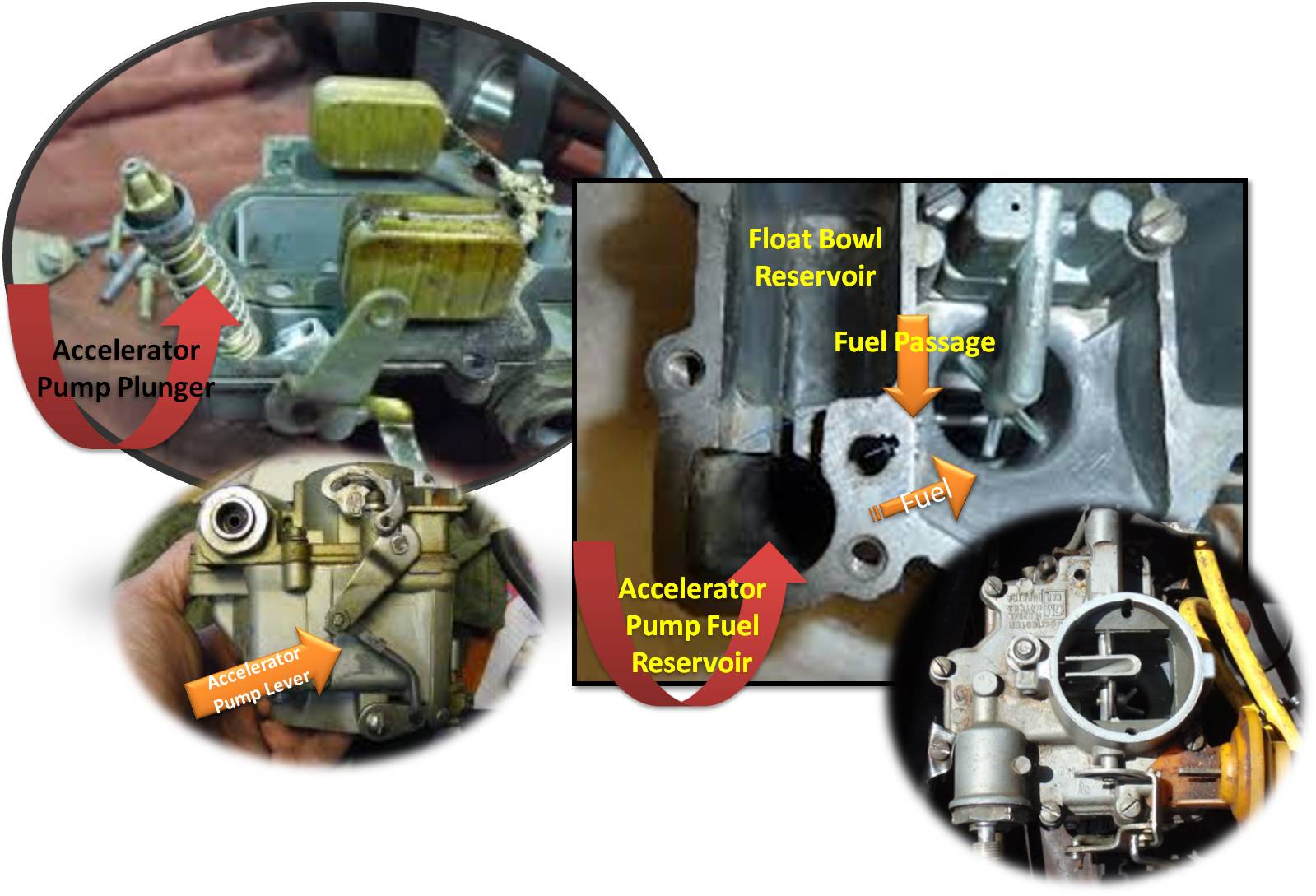
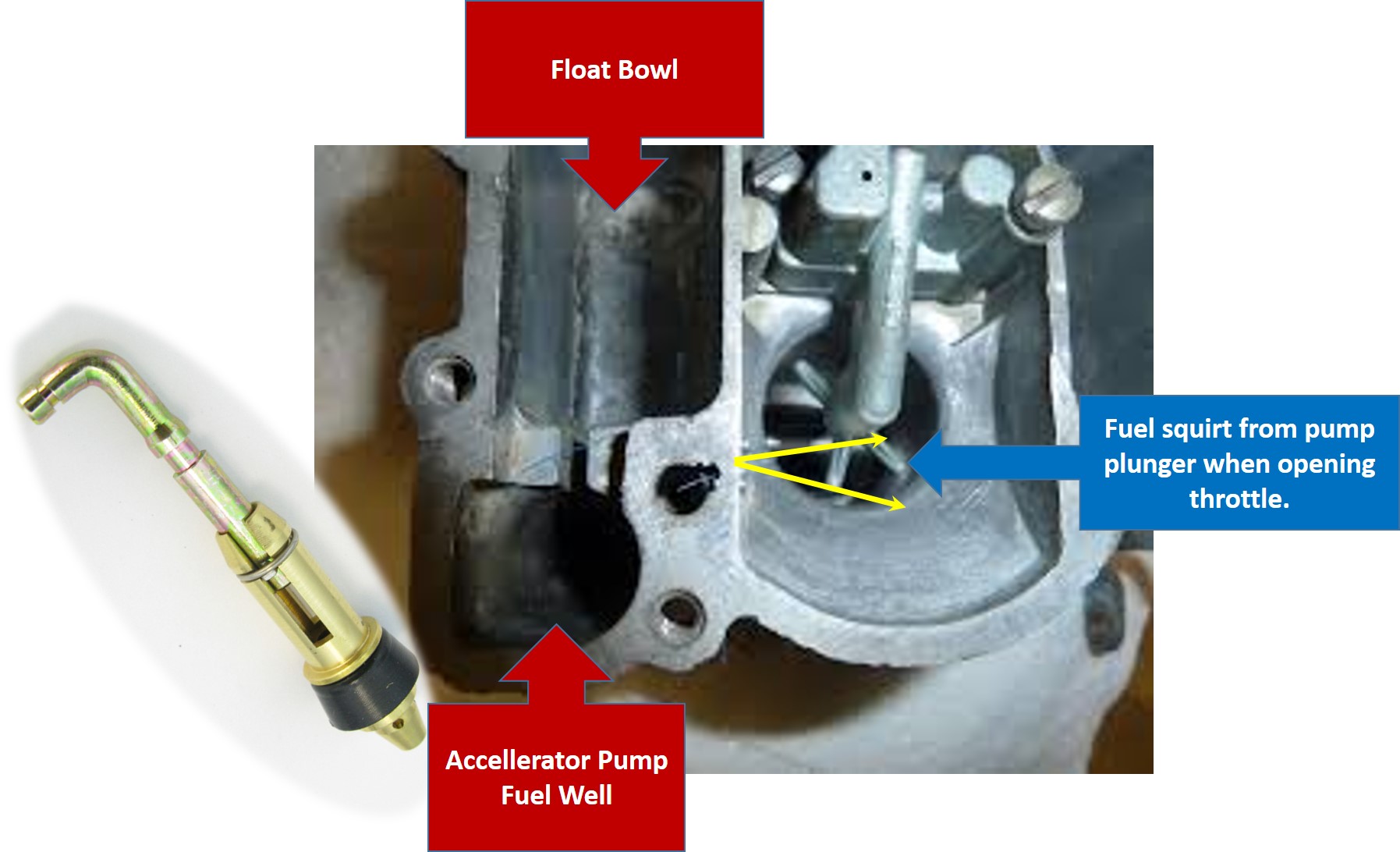
Here is the identification of the early 1960-1961 pump (no longer available) and the 1962-1969 design (getting harder to find). The later mechanical pumps are interchangeable and mount the same as a direct replacement for the early design, as long as you change to the matching later model push rod.

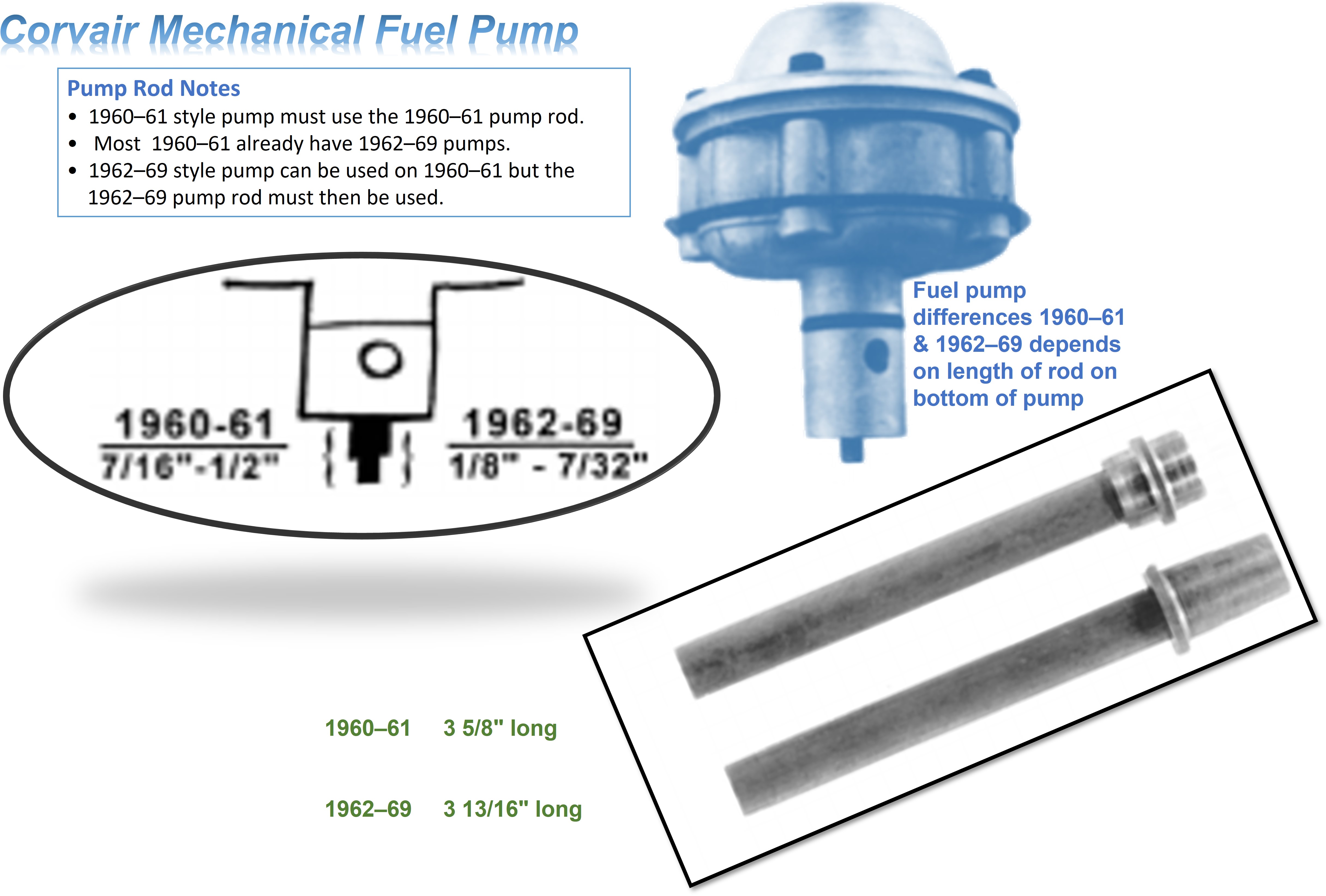


Clark's still shows all mechanical pumps "currently out of stock", and this has been the case for months. There are apparent manufacturing errors, as shown above, and questionable pricing and availability (especially with Airtex). Carter pumps may be better, but that is uncertain. The listings fail to differentiate between fitment for 1961-1969 Corvairs and the unique 1960 fitment (which would work if the pump push rod is changed to match the new, later pumps).
Fuel Pump Vairiations (2).jpg
Even Clark's Corvair Parts seems unable to find a good source for mechanical fuel pumps!



I gave up last year and ultimately switched to a new electric pump. The Corvair mechanical pump market may eventually sort itself out, but with ridiculous pricing variations, faulty fitment with improper drive rod lengths and missing anchor holes in the pump shaft, I would wonder how good the internal diaphragm material is (this was a problem years ago with older replacement pumps).
Although changing to a good electric pump is somewhat complex (to ensure a safe, well-designed installation), we may have reached a point where the aging Corvair mechanical pump is on its way out.
If you find the mechanical pump faulty and you decide to switch to an electric fuel pump, be sure to route your fuel lines safely away from the fan belt and pulleys to prevent potential physical damage and dangerous fuel leaks or engine fire hazards.
ELECTRIC FUEL PUMP CONVERSION IDEAS & SUGGESTIONS
 viewtopic.php?t=17257
viewtopic.php?t=17257
Re: Quick fuel pump question
Posted: Wed Jun 07, 2023 9:08 pm
by 66vairguy
Good info Brad. I have noticed a few posts online were folks ordered Corvair fuel pumps off ebay only to discover they were the early 1960-61 style. Not sure were some of these early fuel pumps have come from, maybe old NORS stock.
I can't recall when a Corvair vendor sold the 60-61 style fuel pump. Most 1960-61 Corvair owners have changed the fuel pump push rod to use the 62-69 fuel pumps.
That said you can't assume. Verify.
Re: Quick fuel pump question
Posted: Thu Jun 08, 2023 1:34 pm
by atomicmoloch
Thank you all for the good info!!
How is the electric fuel pump listed at Clark's regarded?
Re: Quick fuel pump question
Posted: Thu Jun 08, 2023 2:34 pm
by 66vairguy
atomicmoloch wrote: ↑Thu Jun 08, 2023 1:34 pm
Thank you all for the good info!!
How is the electric fuel pump listed at Clark's regarded?
Hard to say. I looks like the "knockoff' pump sold by Carter that looked like the old Airtex. I bought the Carter to test and it was LOUD! What a racket compared to the Airtex. Moot point as Airtex is no longer selling the good pump.
I've never used the Facet fuel pump, but many have and say they work well and are durable. Facet # 40105 (pump only) or # 40101 (pump and kit with fittings). Rated at 3 to 4.5 PSI (will supply 4.5 PSI for Corvair). A lot of the homebuilt aircraft suppliers sell the Facet pumps.
Caution --- vendors seem to confuse the pump and kit numbers. You can just buy the pump and order fittings. The kit includes a mini fuel filter with a fitting that is useless. Fittings are 1/8 - 27 NPT to barb for 5/16" fuel hose. You can order straight or 90 degree elbow. Pumps are usually mounted behind under floor brace (at front of floor pan). Most drill holes and route tank fuel line to pump through brace, then out to fuel line to engine.
Re: Quick fuel pump question
Posted: Thu Jun 08, 2023 3:14 pm
by Dennis66
What I didn't see mentioned is that Clark's sells a 'dummy" fuel pump core. This replicates the center of the original fuel pump (some disassembly and reassembly required) and allows the use of your original metal fuel lines in the engine compartment, and keeps what most people see looking original. I have one on my list of things to order from Clark's. Honestly, I don't want to trust my oil, and the life of my engine to an unknown quality diaphragm in an old NOS or aftermarket fuel pump.
Also of note: You should not mount the fuel pump in your engine compartment, and if possible avoid any rubber fuel hoses in the engine compartment. Our engine compartments, unlike most vehicle engine compartments tend to hold vapors that normally would dissipate out the open bottom (a lot like an inboard boat). Fuel leakage is asking for a fire. Dennis
Re: Quick fuel pump question
Posted: Thu Jun 08, 2023 3:58 pm
by Jake
I keep seeing references to Clarks Dummy fuel pump but I can't find it on their website catalog.
Is "Dummy fuel Pump" the wrong name?
Re: Quick fuel pump question
Posted: Thu Jun 08, 2023 5:48 pm
by bbodie52
Re: Quick fuel pump question
Posted: Thu Jun 08, 2023 6:41 pm
by 66vairguy
If you want a stock look the "dummy" fuel pump section is a good way to go. You also don't have to change any fuel lines.
There is one issue. Like the real fuel pump, the fuel gets heated up as it passes through the dummy fuel pump sections.
I removed the fuel pump, installed the plug, and rotated the lines 180 degrees to place the fuel "T" toward the front of the car, over the balance tube. Neat and clean and the fuel stays cooler in the lines. Only down side is you have to fabricate a line from the "T" to go through the bulkhead to the flexible fuel line.
Re: Quick fuel pump question
Posted: Fri Jun 09, 2023 5:24 am
by Jake
Ah, I see now.
All you have to do is install the bypass plate?
I assume the pump rod must be removed also?
Sorry if these are stupid questions. Ive replaced fuel pumps before but never modified any in any way.
Re: Quick fuel pump question
Posted: Fri Jun 09, 2023 7:25 am
by Dennis66
Yeah, you essentially remove the fuel pump, disassemble it (the pushrod will come out and stay with the diaphragm), and reassemble it with the dummy core. I'll round up my disassembled fuel pump and post a picture later (if someone doesn't beat me to it). Dennis
Re: Quick fuel pump question
Posted: Fri Jun 09, 2023 9:12 am
by 66vairguy
Jake wrote: ↑Fri Jun 09, 2023 5:24 am
Ah, I see now.
All you have to do is install the bypass plate?
I assume the pump rod must be removed also?
Sorry if these are stupid questions. Ive replaced fuel pumps before but never modified any in any way.
Your questions are to the point, not stupid. Everyone has to learn.
Recently davemotohead posted on the other forum (after a discussion of Clark's less friendly return polices in the last couple years) that the fuel pump "dummy" by-pass plate has had "quality" issues prompting some returns. So keep that in mind.
Re: Quick fuel pump question
Posted: Fri Jun 09, 2023 9:38 am
by Dennis66
"Other forum" ? Dennis
Re: Quick fuel pump question
Posted: Fri Jun 09, 2023 12:12 pm
by Jake
I have to continue my fuel pump story because every victory must be celebrated....
I got 2 used, very suspect fuel pumps from a pal of mine, he just had them sitting on the shelf and said I could have them.
"Just give them a try, hopefully they'll fix you up"
I installed the first one and it leaked far worse than my original one. The second one didnt leak, which is a big positive, but it didn't pump either.
While I was looking at my now 3 rotten pumps I decided to back off the screws on my original pump that worked great but wept fuel.
After loosening everything and retightening them I reinstalled the original pump and it works like a champ. Pumps beautifully and doesnt leak at all. I'm still doing an electric pump buts its nice to have it running while I'm planning that job.
I'm just psyched that my new Corvair is not actively leaking fuel for the first time.
Re: Quick fuel pump question
Posted: Fri Jun 09, 2023 7:14 pm
by bbodie52


I don't know if it is possible to develop an internal leak that is not visible form the outside. But keep an eye on the oil level shown on the dipstick. If it rises the contamination/cause may be gasoline leaking down the pump shaft into the crankcase. That type of engine oil contamination leak has been reported by a number of Corvair owners, and can result in serious engine damage. So be cautious with a questionable fuel pump!


